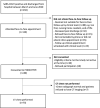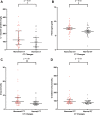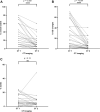CT Lung Abnormalities after COVID-19 at 3 Months and 1 Year after Hospital Discharge
- PMID: 34609195
- PMCID: PMC8515207
- DOI: 10.1148/radiol.2021211746
CT Lung Abnormalities after COVID-19 at 3 Months and 1 Year after Hospital Discharge
Abstract
Background Data on the long-term pulmonary sequelae in COVID-19 are lacking. Purpose To assess symptoms, functional impairment, and residual pulmonary abnormalities on serial chest CT scans in COVID-19 survivors discharged from hospital at up to 1-year follow-up. Materials and Methods Adult patients with COVID-19 discharged between March 2020 and June 2020 were prospectively evaluated at 3 months and 1 year through systematic assessment of symptoms, functional impairment, and thoracic CT scans as part of the PHENOTYPE study, an observational cohort study in COVID-19 survivors. Lung function testing was limited to participants with CT abnormalities and/or persistent breathlessness. Bonferroni correction was used. Results Eighty participants (mean age, 59 years ± 13 [SD]; 53 men) were assessed. At outpatient review, persistent breathlessness was reported in 37 of the 80 participants (46%) and cough was reported in 17 (21%). CT scans in 73 participants after discharge (median, 105 days; IQR, 95-141 days) revealed persistent abnormalities in 41 participants (56%), with ground-glass opacification (35 of 73 participants [48%]) and bands (27 of 73 participants [37%]) predominating. Unequivocal signs indicative of established fibrosis (ie, volume loss and/or traction bronchiectasis) were present in nine of 73 participants (12%). Higher admission serum C-reactive protein (in milligrams per liter), fibrinogen (in grams per deciliter), urea (millimoles per liter), and creatinine (micromoles per liter) levels; longer hospital stay (in days); older age (in years); and requirement for invasive ventilation were associated with CT abnormalities at 3-month follow-up. Thirty-two of 41 participants (78%) with abnormal findings at 3-month follow-up CT underwent repeat imaging at a median of 364 days (range, 360-366 days), with 26 (81%) showing further radiologic improvement (median, 18%; IQR, 10%-40%). Conclusion CT abnormalities were common at 3 months after COVID-19 but with signs of fibrosis in a minority. More severe acute disease was linked with CT abnormalities at 3 months. However, radiologic improvement was seen in the majority at 1-year follow-up. ClinicalTrials.gov identifier: NCT04459351. © RSNA, 2022 Online supplemental material is available for this article.
Conflict of interest statement
Figures








References
-
- WHO announces COVID-19 outbreak a pandemic . https://www.euro.who.int/en/health-topics/health-emergencies/coronavirus.... Published December 3, 2020. Accessed May 22, 2021 .
-
- WHO Coronavirus Disease (COVID-19) Dashboard . https://covid19.who.int/. Accessed January 9, 2021 .
Publication types
MeSH terms
Associated data
LinkOut - more resources
Full Text Sources
Medical
Research Materials

